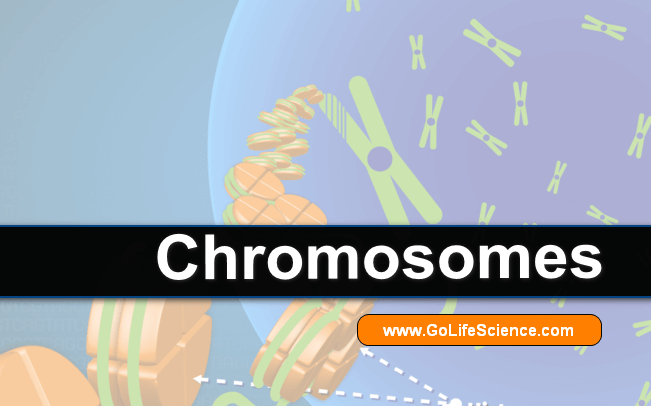
According to Cohn (1964), the term chromatin refers to the Feulgen positive materials observed in the interphase nucleus and later during the division of the cell nucleus. they are long, fine thread-like structures 40 to 150 A0 in diameter.
Ris (1969) has observed that chromatin fibers contain only a single DNA molecule. The term chromosome was coined by W.Waldever in 1888. Does this article give the basic concept of What is the Chromosome Structure and the function?

Sutton of Columbia University published the behavior of chromosomes of cells. Morgan and Sturtevant showed that the units hereby must be arranged in linear order on the chromosomes.
The chromosomes have the ability of self-reproduction and keep their form and the physiological properties through the cell division. They play an important role in variation, heredity, mutation, etc.
Number of Chromosomes
In every species, the number of chromosomes is generally constant containing a diploid number of chromosomes in their somatic cells and a haploid number of chromosomes in their gametes. The chromosomes are tightly packed.
The number of chromosomes contributes to the determination of the taxonomic position of a plant or animal species. The chromosome number differs from species and it may range from two to several hundred.
The smallest number of chromosomes is found in Ascaris megalocephaly, having two somatic chromosomes i.e. one haploid chromosome.
The maximum number of chromosomes is found in protozoan. The group aggregate possesses more than 300 chromosomes while in Radiolaria the number even reaches up to 1600.
In Animals
| Organism | Species | Diploid (2N) Chromosome Number |
| Man | Homo sapiens | 46 |
| Cat | Felix domesticus | 38 |
| Cattle | Bos taurus | 60 |
| Chicken | Gallus domesticus | 78 |
| Dog | Canis familiaris | 78 |
| Donkey | Equus asinus | 62 |
| Frog | Rana pipiens | 26 |
| Fruit fly | Drosophila melanogaster | 8 |
| Grasshopper | Melanoplus differentialis | 24 |
| Honeybee | Apis mellifera | 32 |
| Horse | Equus calibus | 64 |
| House fly | Musca domestica | 12 |
| Mosquito | Culex pipiens | 6 |
| Rabbit | Oryctolagus cuniculus | 44 |
| Red ant | Formica sanguinea | 48 |
| Rhesus monkey | Macaca mulatta | 42 |
In Plants:
| Organism | Species | Diploid (2N) Chromosome number |
| Alfalfa | Medicago sativa | 32 |
| Avocado | Persea americana | 24 |
| Barley | Hordeum vulgare | 14 |
| Bermudagrass | Cynodon dactylon | 36 |
| Broad bean | Vicia faba | 12 |
| Cashew | Anacardium occidentale | 42 |
| Corn (maize) | Zea mays | 20 |
| Cotton, American-Egyptian | Gossypium barbadense | 52 |
| Cotton, upland | Gossypium hirsutum | 52 |
| Durian | Durio zibethinus | 56 |
| Flax | Linum usitatissimum | 30 |
| Garden pea | Pisum sativum | 14 |
| Grape | Vitis vinifera | 38 |
| Guava | Psidium guajava | 22 |
| Kidney bean | Phaseolus vulgaris | 22 |
| Mango | Mangifera indica | 40 |
| Oats, white | Avena sativa | 42 |
| Oats, red | Avena byzantina | 42 |
| Onion | Allium cepa | 16 |
| Papaya | Carica papaya | 18 |
| Peanut | Arachis hypogaea | 40 |
| Pineapple | Ananas comosus | 50 |
| Potato | Solanum tuberosum | 48 |
| Rice | Oryza sativa | 24 |
| Rye | Secale cereale | 14 |
| Sorghum | Sorghum vulgare | 20 |
| Soybean | Glycine max | 40 |
| Squash | Cucurbita pepo | 40 |
| Sugar beet | Beta vulgaris | 18 |
| Sugar cane | Saccharum officinarum | 80 |
| Tamarind | Tamarindus indica | 24 |
| Tobacco | Nicotiana tabacum | 48 |
| Tomato | Lycopersicon esculentum | 24 |
| Wheat, durum | Triticum durum | 28 |
| Wheat, common | Triticum vulgare | 42 |
| Wheat, club | Triticum compactum | 42 |
The shape and Size
- The shape of chromosomes depends on the position of the centromere, on the secondary constriction and on the localization of satellites.
- The chromosomes are generally rod-like and acrocentric, sometimes like V-shaped as amphibians.
- Metaphase or early anaphase is the best condition to observe the shape of the chromosome in an organism cell.
- The length of a chromosome varies from 0.1µ to about 30 µ and the diameter 0.2 µ to 2 µ.
- The set of chromosomes in an individual is, In humans cells, each set of the chromosome is made of 23 chromosomes (22 autosomes and 1 sex chromosome).
- A pair of chromosomes refers to the two homologous chromosomes in a diploid individual (one chromosome from each set for a given chromosome number).
- In contrast, in eukaryotes, all of the cell’s chromosomes are stored inside a structure called the nucleus. Each eukaryotic chromosome structure is composed of DNA coiled and condensed around nuclear proteins called histones.
What is the Chromosome structure?
How is DNA packaged into chromosomes and describe the structure of a chromosome?
The general structure of somatic chromosomes can be studied best at the metaphase and anaphase of mitosis.

Each comprises the following parts:
- Pellicle and Matrix
- Chromonemata (Chromatid during Metaphase)
- Chromomeres
- Centromere
- Satellite bodies
1. Pellicles and Matrix
- Pellicles: It is the outer most covering of the chromosome, formed of non-genetic material. Darlington (1935) and Ris (1945) discarded the presence of pellicle in the chromosome.
- Matrix: Inside the pellicle has filled a jelly-like substance called Matrix. It is also composed of non-genetic material.
- The matrix is formed from the nucleus during telophase of cell division. The structure and function of the matrix are not fully known.
2. Chromonemata
- Embedded in the matrix chromosome, there are two similar and spirally coiled chromonemata.
- These are so intimately held together with each other that they appear to be one.
3. Chromomeres
- There is a present a long thread throughout the chromosome which is called Generally, the chromonema of one chromosome is identical in nature to the chromonemas of other chromosomes in the same cell.
- Each chromonema bears a number of bead-like bodies (beads on a string) called chromomeres. The regions in between chromomeres are inter-chromosomes. The position of the chromomeres is relatively constant for a given chromosome.
- Some authors are of the opinion that chromomeres represent a condensation of nucleoprotein material.
- Others agree with the view that there are regions in which there is a superimposition of coils. DeRobertis in 1956 Ris in 1957 by electron microscopic studies proved that there is nothing like matric between the coils of chromonema and a pellicle surrounding each chromosome.
4. Centromere
- In every chromosome, there is present generally a non-staining region that looks like a constriction. It is called as Centromere or kinetochore.
- During cell division, the spindle fibers remain attached to this region. This point also plays an important role in the chromosomal movement during mitosis.
- Darlington and Schrader suggested that the centromere is very similar to the centriole.
- The centromere and centriole behave similarly during mitosis; they appear similar in the cell and show similar reactions to the stains.
Types of Chromosome
On the basis of position and number of centromeres, the chromosomes may be of following types:

- Acentric: The chromosome which is without centromere is called Acentric.
- Monocentric: When chromosomes have only one centromere, it is known as monomeric.
- Dicentric: A chromosome with two centromeres is termed
- Polycentric: A chromosome possessing more than two centromeres is called polycentric. White in 1936 reported polycentric chromosomes is Ascaris
- Metacentric: When the centromere is present about the middle of the chromosome then the chromosome is termed as metacentric.
- Acrocentric: When centromere is located at the end of the chromosome in the chromosome is termed as telocentric.
- Satellites: The chromosome may have a rounded or elongated body at its end. The rounded body is connected by a thin chromatic filament. It is called a satellite. In diameter, it is equal to or smaller than that of the chromosome on which it is present. Satellite bearing chromosomes are called SAT (sine acido thymonucleinico)
- Telomere: The chromosomal terminations at either end are known as Telomeres (Mullur, 1938). They have specific uniqueness. A broken end of one chromosome can fuse with that of the other chromosome but intact parts of telomeres can’t fuse with that of the other chromosome but the intact parts of telomeres can’t fuse in any case. Because of this type of polarity, the telomere prevents the other chromosomal parts to fuse with them.
Chemical Composition
- The chromosomes are mainly composed of nucleic acids and proteins.
- The DNA and hist-protein combine together and form deoxyribonucleoprotein, which is 90% of the chromosome, DNA being 35%and histone protein about 55%.
- The remaining 10% part of a chromosome is termed as a residual chromosome.
- Stedman (1934) reported another type of protein called Chromosomin in addition to histone or protamines.
Functions of Chromosomes
What is the function of a chromosome in a cell? The chromosome functions are given below
- They control the physiological behavior of an organism with the help of genes present in them.
- We know each chromosome is made up of DNA and this DNA by replication gives rise to messenger RNA (mRNA) which carries the genetic information in the form of code.
- This mRNA comes out of the nuclear wall into the cytoplasm where it helps to form a particular kind of protein needed by the cell or body.
- Sometimes regions within the chromosomes change their position which leads to genetic effects or mutations. Such an effect is termed as position effect which is due to shifting in the position of Heterochromatin and euchromatin parts.
- Heterochromatin aids in the formation of the nucleus.
- They are a hereditary vehicle carrying genetic information from one generation to the other.
Frequently Asked Questions (FAQ)
What Are Homologous Chromosomes?
Homologous chromosomes are made up of chromosome pairs of approximately the same length, centromere position, and staining pattern, for genes with the same corresponding loci. Onehomologous chromosome is inherited from the organism’s mother; the other is inherited from the organism’s father.
What two structures make up a single replicated chromosome?
Sister Chromatids made up a single replicated chromosome
What is the structure that organizes the motion of chromosomes?
Centriole is organizing the motion of chromosomes in cell division.
What is Sister Chromatids?
A sister chromatid refers to the identical copies (chromatids) formed by the DNA replication of a chromosome, with both copies joined together by a common centromere. In other words, a sister chromatid may also be said to be ‘one-half’ of the duplicated chromosome.
Q. What structure is responsible for moving the chromosomes during mitosis?
Ans: Spindle Fibres.
Q. What are the major changes in chromosome structure?
Ans: The Major changes in chromosome structure is Translocations, Deletions, Duplications, Inversions, Isochromosomes, Dicentric chromosomes, and Ring chromosomes.
Q. How many chromosomes are in each daughter cell at the end of mitosis?
Ans: Daughter cells have 46 chromosomes
Additional Resources:
- Cytogenetics is the study of chromosomes and chromosome rearrangements. This area of research is germane to several areas of biological research.
- Cytogenetics has been fundamental to understanding the evolutionary history of a species (for example, although the gorilla and the human are morphologically very different, at the level of the chromosome (and DNA sequence) they are extremely similar.
